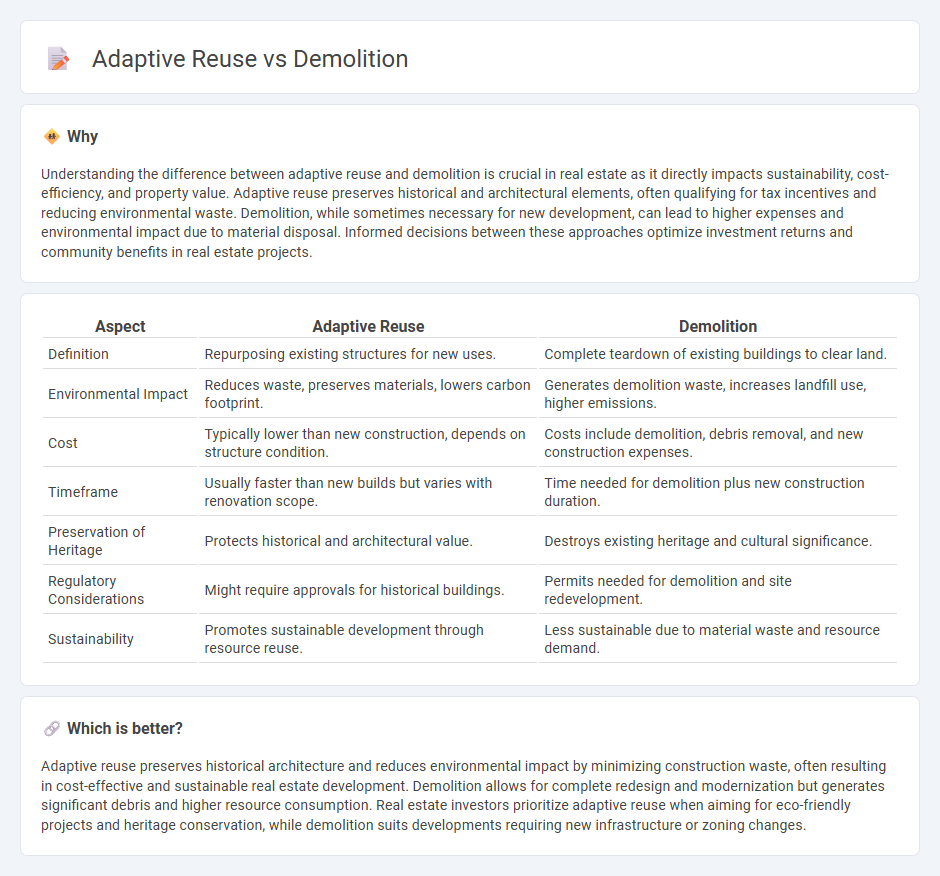
Adaptive reuse preserves the architectural integrity and sustainability of existing real estate by transforming outdated buildings into functional spaces, while demolition clears land for new construction, often increasing development flexibility but generating substantial waste. Studies show adaptive reuse can reduce construction waste by up to 75% and lower environmental impact, making it a favored strategy in urban redevelopment. Explore further to understand which approach maximizes value in your next real estate project.
Why it is important
Understanding the difference between adaptive reuse and demolition is crucial in real estate as it directly impacts sustainability, cost-efficiency, and property value. Adaptive reuse preserves historical and architectural elements, often qualifying for tax incentives and reducing environmental waste. Demolition, while sometimes necessary for new development, can lead to higher expenses and environmental impact due to material disposal. Informed decisions between these approaches optimize investment returns and community benefits in real estate projects.
Comparison Table
| Aspect | Adaptive Reuse | Demolition |
|---|---|---|
| Definition | Repurposing existing structures for new uses. | Complete teardown of existing buildings to clear land. |
| Environmental Impact | Reduces waste, preserves materials, lowers carbon footprint. | Generates demolition waste, increases landfill use, higher emissions. |
| Cost | Typically lower than new construction, depends on structure condition. | Costs include demolition, debris removal, and new construction expenses. |
| Timeframe | Usually faster than new builds but varies with renovation scope. | Time needed for demolition plus new construction duration. |
| Preservation of Heritage | Protects historical and architectural value. | Destroys existing heritage and cultural significance. |
| Regulatory Considerations | Might require approvals for historical buildings. | Permits needed for demolition and site redevelopment. |
| Sustainability | Promotes sustainable development through resource reuse. | Less sustainable due to material waste and resource demand. |
Which is better?
Adaptive reuse preserves historical architecture and reduces environmental impact by minimizing construction waste, often resulting in cost-effective and sustainable real estate development. Demolition allows for complete redesign and modernization but generates significant debris and higher resource consumption. Real estate investors prioritize adaptive reuse when aiming for eco-friendly projects and heritage conservation, while demolition suits developments requiring new infrastructure or zoning changes.
Connection
Adaptive reuse and demolition are interconnected processes in real estate development, where adaptive reuse involves repurposing existing structures to extend their lifecycle, while demolition clears obsolete or unsafe buildings to make way for new construction. Efficient assessment determines whether a building's structural integrity justifies adaptive reuse or demands complete demolition, impacting sustainability and project costs. Integrating adaptive reuse strategies can reduce waste and preserve architectural heritage, contrasting with demolition's environmental footprint and urban renewal potential.
Key Terms
Zoning Regulations
Zoning regulations significantly impact the decision between demolition and adaptive reuse by dictating land use, building height, density, and occupancy types. Adaptive reuse projects often benefit from zoning variances or historic preservation overlays, allowing retention of existing structures while meeting updated codes. Explore detailed zoning policies to determine the most viable approach for your property redevelopment.
Structural Integrity
Demolition often results in complete loss of structural components, leading to increased waste and environmental impact. Adaptive reuse preserves foundational elements, maintaining the building's structural integrity while minimizing costs and resource consumption. Explore how adaptive reuse strategies can extend the lifecycle of structures and promote sustainable development.
Historic Preservation
Demolition of historic structures often leads to irreversible loss of cultural heritage and architectural significance, whereas adaptive reuse preserves the historic fabric while integrating modern functions, promoting sustainability and community identity. Adaptive reuse reduces construction waste and carbon emissions compared to demolition and new building, aligning with sustainable historic preservation goals. Explore how adaptive reuse strategies can balance heritage conservation with contemporary needs for insightful preservation solutions.
Source and External Links
Demolition - Demolition is the science and engineering of safely and efficiently tearing down buildings and other artificial structures.
Demolition - Overview - OSHA provides guidelines and standards to manage the hazards associated with demolition work.
Demolition (2015) - A 2015 American comedy-drama film about a man whose life unravels after his wife's death.
 dowidth.com
dowidth.com